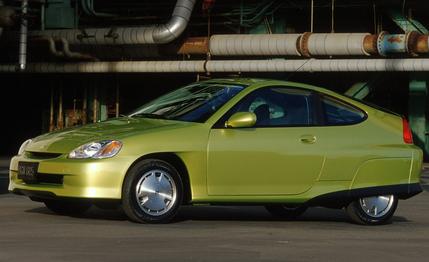 Long-Term Road Test
Long-Term Road Test
We're all victims of our expectations at one time or another, so perhaps you'll forgive us when we tell you we are just a bit disappointed with the bottom line here: 48 miles to the gallon. That's the fuel economy posted by our Honda Insight over the 40,000-mile term of the test. And we have no one to thank but ourselves.
Perspective: For people trundling around in Lincoln Navigators and Cadillac Escalades, 48 mpg would be unimaginable, inconceivable, unattainable—presuming those people care about such calculations, which is an unwarranted presumption.
But we do care, at least on occasion. And that's how we set ourselves up to feel a little let down by the Insight's overall fuel consumption. See, when we were just getting acquainted with this extraordinary engineering achievement, we participated in a fuel-economy contest ("How We Won the Insight Fuel-Economy Challenge. Without Cheating. Much." January 2000) and came home with the trophy after averaging 121.7 mpg over the 195-mile run. The second-place entry managed a paltry 83.4 mpg.
As the headline suggests, we were creative in our reading of the rules. The regs said nothing to prohibit close-quarters drafting behind a Ford Excursion rigged with a homemade rear air dam, thus punching a Hindenburg-size hole in the air. So that's exactly what we did.
But that's beside the point. The point is that the Insight was rated for 70 mpg on the highway and 61 in the city by the EPA, and we achieved only 48, just 7 mpg more than the long-term Honda Civic VX we wrote about in July 1993. The VX was a much more conventional econocar, devoid of the Insight's hybrid techno-dazzle: a 67-hp, 1.0-liter lean-burn three-cylinder VTEC-E gas engine assisted, when the driver demands, by a 13-hp electric motor that also replenishes battery energy during deceleration. So, what's the deal?
Heavy throttle feet, that's what. There were logbook episodes in which fuel economy soared north of 60 mpg, but for the most part the econometer hovered around 50 mpg. The Insight opens new vistas in fuel economy, but as with any vehicle, haste is the enemy of good gas mileage.
Although some drivers worked to keep the numbers up and the booster motor battery in a high state of charge, for most of us the Insight's tall gearing provoked a lot of downshifting, especially during the cut and thrust of urban driving. Honda's little hybrid has no trouble keeping pace with commuter traffic, thanks to the electric motor's boost, but when the revs soared in second and third gears, the fuel-economy meter invariably lost altitude.
There were other areas of moderate discontent. For example, several drivers complained that the Insight's auto shut-off, designed to kill the engine at stoplights and thus save fuel consumed in idling, was inconsistent and, as a consequence, irritating.
Auto-shut-off inconsistencies were merely annoying, but another persistent complaint was more serious. The Insight's skinny little Bridgestone Potenza tires (165/65SR-14) didn't do much for straight-line stability, making the car far too sensitive to vagaries such as pavement rain grooves, truck ruts, standing water, and gusty winds. "Very twitchy on the highway," commented one chronicler. "This car demands more attention to drive than most."
This trait was aggravated by the addition of a set of Bridgestone Blizzak snow tires. We have high respect for Blizzaks, but in this application they didn't work well in dry conditions. In fact, one logbook note flatly stated that the winter tires "ruin the car. It's virtually undrivable on the freeway on these big, tall, wobbly tire-tread blocks."
We began to suspect there might be more to the Insight's rather touchy behavior than just the tires and decided to check the toe settings. The theory, set forth by Squire Csere, was that with mpg as a be-all, end-all priority, Honda probably selected toe specs to augment same. And so it proved to be. Insights are delivered with zero toe at the front, minimizing rolling resistance but exaggerating the car's response to pavement irregularities and the other variables listed above. We experimented with a little front toe-in—just an eighth of an inch—and found that it had a profound effect on fuel economy, which deflated from 68.6 mpg to 63.2 at a steady-state 60 mph (these data were excluded from the official mileage tally). However, we did note improved turn-in and marginally better straight-line stability. Major improvements are hampered by the narrower rear track, which maximizes the likelihood that at least one of the four tires is riding on a poor section of pavement.